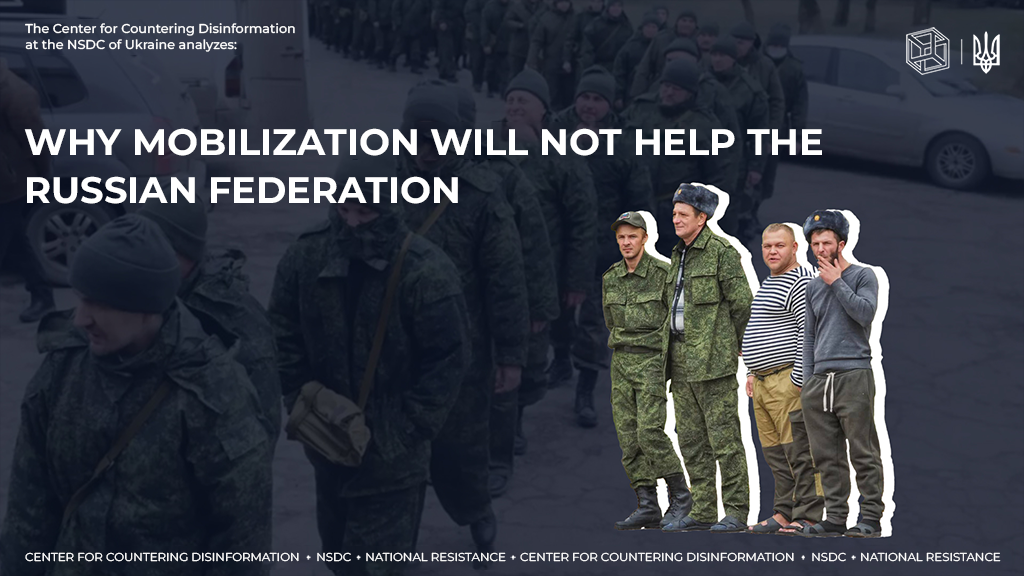The Center for Countering Disinformation at the National Security and Defense Council of Ukraine analyzed coverage of the topic of military mobilization in the russian federation before its official announcement.
Since the beginning of the war in Ukraine, the kremlin’s official speakers have absolutely denied the possibility of mobilization in the russian federation several times and have convinced their population that “everything is going according to plan.” In particular, vladimir putin assured at the beginning of March that “only contract soldiers are fighting and there will be no additional draft of reservists from the reserve.”
Even after the so-called goodwill gesture of the occupiers in Kyiv region, Chernihiv region, and Sumy region, at the end of March, a member of the federation council of the russian federation a.klishas was convinced: “mobilization is not foreseen, nor is a complete ban on leaving for all russians or population groups.”
The lack of quick victories in Donbas in April and May provoked calls among the “hurrah-patriots” about the need for general mobilization. But officials in May continued to insist on the absence of prerequisites for such measures:
● d.peskov, the spokesman of the kremlin: “This is not true, this is nonsense”;
● v. volodin, the chairman of the state duma: “about mobilization: No! I will tell you this on and off the air”;
● yu. shvitkin, state duma defence committee: “rumors appear on foreign sources to sow panic among the population”;
● ministry of culture of the russian federation: “regarding mobilization armor for cultural workers is a fake”;
● a. gurulev, state duma defence committee: “the draft law on removing age restrictions for contract workers cannot be considered as any form of mobilization.”
During June-July, against the background of putin’s “we haven’t seriously started anything yet”, the ministry of defence of the russian federation officially assured: “several foreign media spread unreliable information about the alleged mobilization of some kind.”
v.bondarev, a representative of the defense committee of the federation council of the russian federation, was also convinced that “there is no need for an additional draft in the russian army in the context of a special operation.” And the spokesman of the kremlin, d.peskov, repeatedly responded with theses – “these are false information “spread ” and “these are pure fakes.”
The long-running TV series about the “planned successes of the special operation”, which had been fed to the population of the russian federation since the invasion, required propaganda to continue lying about real affairs at the front until mid-September:
● a. klimov, member of the council of the federation: “there is no need to introduce mobilization… The enemy would like to see mobilization in russia and the people would start to “buzz” and they would get the main thing”;
● l. slutsky, head of the LDPR: “there is no need to be afraid of rumors about mobilization”;
● a. gurulev, deputy of the state duma: “currently there is no such need.”
Even the spokesman of the kremlin, d.peskov, was convinced as early as September 13: “at the present moment, there is no question of mobilization in russia.” So, putin’s sudden announcement of a “partial” mobilization came as a surprise not only to the population intoxicated by propaganda, but also to officials close to power. This once again proved the worthlessness of their previous public statements.
In the history of the russian empire, similar mobilization measures have already taken place three times. For the first time, general mobilization in the russian empire was announced by Tsar Nicholas II in July 1914, declaring that russia would not allow the occupation of Serbia.
At the same time, Germany declared a “state of threat of war” and issued an ultimatum: either russia will stop mobilization, or Germany will declare war on russia. But the tsar’s ambitions were already impossible to stop.
Despite the statement of the official propaganda of that time about the mass patriotic enthusiasm of the conscripts, for the absolute majority of the peasants, the conscription during the harvest became a tragedy. And the poor organization of logistics led to riots and pogroms.
Numerous attempts to refuse to fight in a foreign land were severely punished. According to historians, “it rose as if people were being sent to the cemetery.”
In the end, the aggressive war dragged on and led to huge casualties, resulting in tectonic socio-political changes and the collapse of the russian empire and the assassination of the royal family.
The second mobilization took place in 1941, but it had a defensive “patriotic” character. In view of Stalin’s massive repression of the officer corps on the eve of the war, at the beginning of the fascist invasion, the military elite remained, capable of fighting only with a “shaft of fire” and “soldier’s minced meat.” The victory was achieved with the help of American weapons and mass mobilization with huge human losses.
Later, in 1979-1989, the covert mobilization for the Afghan war eventually led to consequences similar to the First World War – the empire collapsed again.
Thus, mobilization can only be effective in the context of a defensive war, when citizens are aware of the existential need to fight the enemy to the last. And the mobilization for external aggression without the corresponding internal motivation of the fighters inevitably leads to the collapse and disintegration of the empire.
Therefore, the russian population, which for six months was told about the “heroic feats” of the professional army, the “high precision of the space forces” and the repeated destruction of all “neo-Nazis”, according to historical parallels, should prepare for the collapse of their half-empire. And it started to this next disaster, putin implemented his decree on “partial” mobilization.










